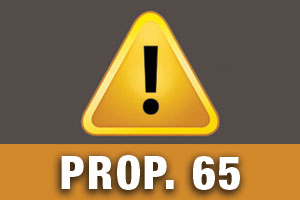Four pre-regulatory proposals that would substantially increase the amount of Proposition 65 warnings, increase frivolous “shakedown” lawsuits, and unjustifiably weaken the scientific basis for warning levels have been released by the state Office of Environmental Health Hazard Assessment (OEHHA).
These results directly undermine the Governor’s calls for Proposition 65 reform in May 2013, when he sought to decrease the number of warnings, curb frivolous litigation, and strengthen the scientific basis for warning levels.
The California Chamber of Commerce and a vast coalition of organizations and businesses that will be affected by OEHHA’s proposals will be engaged throughout the pre-regulatory and regulatory processes.
Response to Petition, Beech-Nut Case
OEHHA’s proposals, released August 28, are nominally in response to a request by the Center for Environmental Health (CEH) that OEHHA rescind the safe harbor level for lead and establish a new, much lower one. The current safe harbor level for lead, established by OEHHA’s predecessor agency in 1989, is 0.5 micrograms/day.
But OEHHA’s proposals address issues well beyond the scope of CEH’s request and instead seek to overturn the 2015 appellate court ruling in Environmental Law Foundation v. Beech-Nut, et al. In that case, the appellate court ruled that fruit and fruit juice products did not require Proposition 65 warnings for lead exposure.
Among other things, the Beech-Nut court found that it is scientifically appropriate to average levels of product use over multiple days to estimate exposure levels to lead when making a decision about whether to provide a warning. Specifically, the court permits higher levels of exposure when there are intervening days of no exposure (in this case, the average consumer ate peaches only once every two weeks).
Proposals Worsen Proposition 65 Climate
- First, OEHHA has proposed to significantly lower the exposure level (Maximum Allowable Dose Level, or MADL) at which a warning is required for lead. The proposal would slash the current level of 0.5 micrograms/day to 0.2 micrograms/day.
Acknowledging the Beech-Nut ruling, OEHHA would permit higher levels when there are intervening days of no exposure, but would set these levels 60% lower than permitted by the Beech-Nut court.
Proposition 65 already has an extraordinarily conservative safety factor built into the statute, which makes the current lead MADL the most conservative in the world. OEHHA’s proposal is not necessary to protect public health, and will result in a proliferation of new warnings in a state that already has a reputation for “overwarning.”
- Second, OEHHA has proposed that the MADLs for 35 other reproductive toxicants will now be considered single-day limits such that exposures to these chemicals cannot be averaged over periods longer than one day (e.g., if the average consumer consumed a product only once every two weeks).
This proposal fundamentally undermines science demonstrating that, like lead, different reproductive toxicants act differently over time. This proposal would require businesses to make extraordinarily conservative and baseless presumptions when making warning decisions, thus requiring warnings in many instances where they are not required today.
- Third, OEHHA has proposed to bar courts from considering what the most appropriate measure is for determining the average user of a product and instead require businesses to use the “arithmetic mean.”
For many products, including food, the distribution of exposures is highly skewed and a very small number of consumers are exposed at higher levels while the vast majority of consumers are exposed at very low levels.
The arithmetic mean would allow the outliers to skew the mean, which in many cases would result in the need to provide a warning when 85% of the population would not need one.
- Fourth, OEHHA has proposed to require that, for food products, Proposition 65 compliance be evaluated for each and every lot of finished product that leaves the processing facility. But just as individual consumers use a product differently, different units of the same products can contain different levels of a listed chemical. Today, businesses in this context make warning decisions by analyzing this variability, and courts routinely take expert testimony on the issue.
Under OEHHA’s proposal, businesses would be required to undertake significant testing for each and every commodity and must be able to trace the “lot” from which each item came, a nearly impossible task. Additionally, food manufacturers don’t have standard “lots” for testing purposes that would provide any reliable information. The costs associated with this proposal would be astronomical, and private enforcers will have several new pathways to sue food manufacturers and retailers.
Workshop, Comments Due
OEHHA held a pre-regulatory workshop on the lead MADL and reproductive toxicant averaging proposals on October 14 in Sacramento. CalChamber will be submitting comments on these proposals. Comments must be submitted by October 28.
Another workshop on the arithmetic mean and lot averaging proposals was held on October 19 in Oakland. Comments on these proposals must be submitted by November 17.
Staff Contact: Anthony Samson

